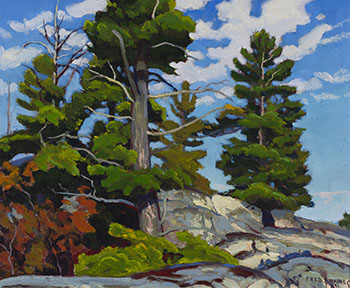
Frederick Stanley Haines (1879-1960) was a pivotal figure in the Canadian art scene, known for his significant contributions as a painter, printmaker, educator, and administrator. Born in Meaford, Ontario, Haines' early life was marked by a profound passion for art, a passion that would shape his entire career and leave a lasting impact on Canadian culture.
Early Life and Education
Haines’ artistic journey began in earnest when he moved to Toronto in 1896 at the age of seventeen. Despite his young age, he demonstrated enough talent to paint portraits for a traveling dealer, earning enough money to fund his studies at the Central Ontario School of Art. There, he studied under the guidance of G.A. Reid and William Cruikshank, both influential figures in Canadian art. His early exposure to these mentors set the stage for his later success.
European Influence and Artistic Development
In 1913, Haines traveled to Belgium, where he studied at the Académie Royale des Beaux-Arts in Antwerp under Juliaan de Vriendt. His time in Belgium was formative; he was awarded a gold medal in figure painting and gained valuable experience that would later influence his work. This period also marked his recognition in the publication Canada and Its Provinces, where his paintings of animals were noted for their knowledge and strength of execution.
Rising Prominence in Canada
Returning to Canada, Haines’ career continued to ascend. In 1919, he became an associate member of the Royal Canadian Academy and began producing his first prints. His expertise in graphic arts led to his appointment as Secretary, and later Commissioner of Fine Arts, at the Canadian National Exhibition (CNE). During the 1920s and 1930s, Haines played a crucial role in introducing the works of European modernists like Picasso and Dali to Canadian audiences, a progressive move that showcased his forward-thinking approach to art.
Leadership Roles and Contributions to Art Education
Haines’ leadership abilities were recognized when he was elected President of the Ontario Society of Artists in 1924, following the retirement of Robert Holmes. His career took another significant step forward in 1928 when he was appointed Curator of the Art Gallery of Toronto. However, his most enduring legacy may be his tenure as Principal of the Ontario College of Art (now OCAD University) from 1932 to 1951. During his time as principal, Haines introduced innovative practices inspired by his studies in Antwerp, including the establishment of a director’s studio within the school and a separate studio for advanced students.
Haines' open-mindedness toward different styles of art, including abstract and non-objective art, despite not practicing them himself, demonstrated his inclusive and supportive approach to art education. His influence on generations of Canadian artists is undeniable.

Later Years and Legacy
After retiring from the Ontario College of Art, Haines returned to full-time painting, focusing on his studio in Thornhill, Ontario. His later years were marked by continued contributions to the art community, including the donation of numerous paintings to local high schools. His work was celebrated in a memorial exhibition at the Art Gallery of Toronto in 1961, which later traveled to other galleries across Ontario. The exhibition, which included paintings, sketches, prints, and drawings, was a testament to his versatility and talent.
Haines' contributions to Canadian art were multifaceted. Beyond his artistic achievements, he was also a flautist, a golfer, and an erudite collector of Chinese snuff bottles, illustrating his wide-ranging interests and talents. His impact on Canadian life and culture was profound, and he is remembered not only as a gifted artist but also as a dedicated educator, administrator, and a man of many talents.
Conclusion
Frederick Stanley Haines left an indelible mark on Canadian art through his work as an artist, educator, and curator. His commitment to advancing the arts in Canada, coupled with his talent and leadership, ensured that his influence would be felt long after his passing in 1960. As Charles Comfort aptly put it in the foreword to Haines’ memorial exhibition catalog, "Fred Haines was a whole man... He has made a very real contribution to Canadian life and culture and will always be remembered as an artist, an educator, an able administrator, a loyal friend, and a Christian gentleman."
Browse our collection of Canadian paintings for sale at the Canadian Classic Fine Art gallery, The best place to buy a painting online. We provide free shipping anywhere in Canada and the United States. Our Montreal art gallery sells paintings online exclusively and have a 14 days return policy.
